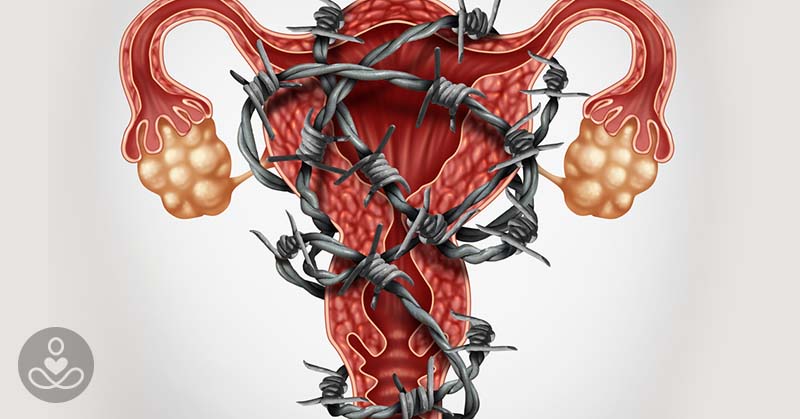This article was originally published on April 17, 2018, and has since been updated.
Over the last few years, there has been a growing list of women advocating for endometriosis sufferers. But now, in addition to the common symptoms, researchers have linked this painful condition to increased risk of heart disease.
What Is Endometriosis?
Endometriosis is a common condition that is often poorly understood. It occurs when tissue, similar to the uterine lining (i.e., the endometrium), grows outside the uterus.
This condition can start as early as a girl’s first period. However, since women and medical professionals have such a lack of awareness, individuals with endometriosis are often diagnosed and treated much later in life – if at all.
Currently, the U.S. Department of Health and Human Services Office on Women’s Health estimates that endometriosis affects just over 1 in 10 women, typically between the ages of 15 and 49.[1]
Where some doctors believe that menstrual tissue ends up in the abdomen where it implants and grows, some studies suggest that certain people are genetically predisposed to the condition.[2,3] But, although the root cause of endometriosis remains unknown, some telling signs exist.

Common Symptoms of Endometriosis
As outlined on Endometriosis, they can include but are not limited to:[4,5]
- Painful periods
- Painful ovulation
- Pain during or after sexual intercourse
- Heavy bleeding
- Chronic pelvic pain
- Fatigue
- Infertility, or inability to get pregnant
- Digestive problems (e.g., diarrhea, constipation, bloating, nausea)
- Overall lower quality of life
The Link Between Endometriosis and Coronary Heart Disease
In March 2016, a study published in Circulation: Cardiovascular Quality and Outcomes explored data from 116,430 women between the ages of 25 and 42. The participants, whose data was collected over the course of two decades (1989-2009), did not have any history of stroke or heart disease.
“Women with endometriosis should be aware that they may be at higher risk for heart disease compared to women without endometriosis, and this increased risk may be highest when they are young,” said lead author Dr. Fan Mu, who was actually a research assistant at Brigham and Women’s Hospital and Harvard Medical School in Boston at the time of the study.[6]
Researchers found that, when compared to women without the condition, those who had endometriosis were:[7,8]
- 35x more likely to require stents to clear blocked arteries
- 52x more likely to suffer from a heart attack
- 91x more likely to develop (possibly chronic) chest pain
*For women over 40-years-old, their risk of the above conditions was 3x higher.
In addition to women’s increased risk of heart disease, researchers also linked endometriosis to health issues, such as:[8]
- Chronic inflammation
- High levels of low-density lipoprotein (i.e., LDL or “bad”) cholesterol
If You Have Endometriosis, Here’s How to Protect Your Heart Health
“It is important for women with endometriosis— even young women—to adopt heart-healthy lifestyle habits, be screened by their doctors for heart disease, and be familiar with symptoms because heart disease remains the primary cause of death in women,” said senior study author Dr. Stacey Missmer, Director of Epidemiologic Research in Reproductive Medicine at Brigham and Women’s Hospital.
Following Dr. Clyde’s “Life’s Simple 7” can help reverse the early death trend that researchers are predicting to his North America by 2020. Taking these seven simple steps serious will not only protect your heart but might even boost your lifespan by another ten years.
- Start getting physically active
- Know and control your cholesterol levels
- Consistently eat healthy, whole foods
- Know and control your blood pressure
- Achieve a healthy weight – and maintain it
- Lower and manage your diabetes risk
- Live a tobacco-free life

Sources:
- Buck, G. M., Hediger, M. L., Peterson, C. M., Croughan, M., Sundaram, R., Stanford, J., . . . ENDO, G. R. (2011, August). Incidence of endometriosis by study population and diagnostic method: The ENDO study. Retrieved April 17, 2018, from https://www.ncbi.nlm.nih.gov/pubmed/21719000
- Uno, S., Zembutsu, H., Hirasawa, A., Takahashi, A., Kubo, M., Akahane, T., . . . Nakamura, Y. (2010, August). A genome-wide association study identifies genetic variants in the CDKN2BAS locus associated with endometriosis in Japanese. Retrieved April 17, 2018, from https://www.ncbi.nlm.nih.gov/pubmed/20601957
- ENDOMETRIOSIS. (n.d.). Retrieved April 17, 2018, from https://www.idph.state.il.us/cancer/factsheets/endo.htm
- ESHRE Guideline for the Diagnosis and Treatment of Endometriosis. (n.d.). Retrieved April 17, 2018, from https://guidelines.endometriosis.org/
- Impact of endometriosis on quality of life and work productivity: A multicenter study across ten countries. (2011, June 30). Retrieved April 17, 2018, from https://www.sciencedirect.com/science/article/pii/S0015028211008764
- Women with endometriosis at higher risk for heart disease. (n.d.). Retrieved April 17, 2018, from https://newsroom.heart.org/news/women-with-endometriosis-at-higher-risk-for-heart-disease
- Harvard Health Publishing. (n.d.). Endometriosis linked to increased risk of heart disease. Retrieved April 17, 2018, from https://www.health.harvard.edu/womens-health/endometriosis-linked-to-increased-risk-of-heart-disease
- Mu, F., Rich-Edwards, J., Rimm, E. B., Spiegelman, D., & Missmer, S. A. (2016, May). Endometriosis and Risk of Coronary Heart Disease. Retrieved April 17, 2018, from https://www.ncbi.nlm.nih.gov/pmc/articles/PMC4940126/

